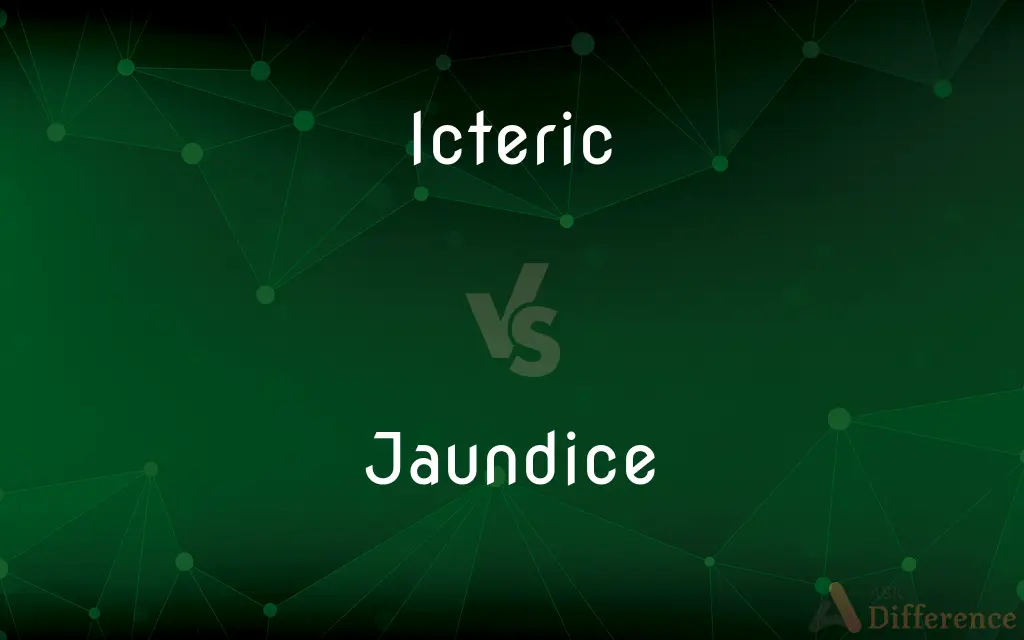Icteric vs. Jaundice — What's the Difference?
Edited by Tayyaba Rehman — By Urooj Arif — Updated on April 4, 2024
Icteric refers to the condition or state of having jaundice, characterized by yellowing of the skin and eyes, while jaundice itself is the yellow discoloration due to high bilirubin levels in the blood.

Difference Between Icteric and Jaundice
Table of Contents
ADVERTISEMENT
Key Differences
Icteric is an adjective used to describe the symptomatic yellow appearance of the skin and eyes associated with jaundice, indicating the presence of the condition. Jaundice, on the other hand, is a noun describing the medical condition itself, characterized by the yellowish pigmentation of the body tissues due to the accumulation of bilirubin.
While "icteric" is used primarily in a clinical or medical context to describe the appearance or state of a patient exhibiting symptoms of jaundice, "jaundice" is used to refer both to the symptom of yellowing skin and to the underlying condition that causes this symptom, including liver dysfunction, bile duct obstruction, or hemolytic disorders.
The term "icteric" can be applied to symptoms and signs that indicate the presence of jaundice, such as icteric sclera (yellowing of the white part of the eyes). Jaundice encompasses the broader implications and causes of the yellowing, including the diagnosis, treatment, and prognosis of conditions leading to high bilirubin levels.
Both terms are related to the diagnosis and observation of liver-related diseases, but "icteric" focuses more on the clinical observation of the symptoms, while "jaundice" refers to the condition as a whole, including its pathophysiology, causes, and implications.
Understanding the distinction is important in the medical field for accurate communication and documentation. When a patient is described as "icteric," it specifically refers to their yellowish appearance, a key symptom. When someone is said to have "jaundice," it encompasses the entire clinical picture, not just the visible symptoms.
ADVERTISEMENT
Comparison Chart
Definition
Adjective describing the yellowish appearance due to jaundice.
The condition marked by yellowing of the skin and eyes due to high bilirubin levels.
Usage
Used to describe symptoms or signs.
Refers to both the symptom and the underlying condition.
Focus
On the symptomatic appearance.
On the condition, its causes, and implications.
Context
Clinical observation and description.
Diagnosis, treatment, and broader understanding of the disease.
Examples
Icteric sclera, icteric skin.
Liver dysfunction, bile duct obstruction, hemolytic disorders leading to jaundice.
Compare with Definitions
Icteric
Characterized by the yellowing of the skin and eyes.
The patient presented with icteric skin and sclera, indicating jaundice.
Jaundice
A condition resulting in yellow discoloration of the skin and eyes.
Jaundice in newborns is common but usually resolves without treatment.
Icteric
Indicates the presence of jaundice in a patient.
The icteric appearance of the patient's eyes was the first clue to his liver condition.
Jaundice
Indicates liver dysfunction or other related health issues.
The diagnosis of jaundice led to further testing to uncover an underlying liver problem.
Icteric
Refers to the symptomatic yellow coloration due to high bilirubin.
The doctor noted the icteric discoloration in her notes.
Jaundice
A term used in both clinical and non-clinical contexts.
The family noticed the baby's jaundice and brought it to the doctor's attention.
Icteric
Primarily a descriptor in clinical settings.
The icteric condition of the patient worsened, prompting immediate intervention.
Jaundice
Can be a symptom of various diseases affecting bilirubin metabolism.
His jaundice was eventually traced back to a blocked bile duct.
Icteric
Used in medical documentation to describe jaundice symptoms.
Upon examination, the newborn appeared icteric, necessitating further tests.
Jaundice
Associated with elevated bilirubin levels in the bloodstream.
The lab tests confirmed jaundice with significantly high bilirubin levels.
Icteric
Relating to or affected with jaundice.
Jaundice
Jaundice, also known as icterus, is a yellowish or greenish pigmentation of the skin and whites of the eyes due to high bilirubin levels. Jaundice in adults is typically a sign indicating the presence of underlying diseases involving abnormal heme metabolism, liver dysfunction, or biliary-tract obstruction.
Icteric
Used to treat jaundice.
Jaundice
Yellowish discoloration of the whites of the eyes, skin, and mucous membranes caused by deposition of bile salts in these tissues. It occurs as a symptom of various diseases, such as hepatitis, that affect the processing of bile. Also called icterus.
Icteric
A remedy for jaundice.
Jaundice
A state or feeling of negativity or bitterness arising especially from envy or world-weariness.
Icteric
(medicine) Jaundiced (having icterus); having yellowing of the skin, mucous membranes of the sclerae of the eyes, or other parts of the body.
Jaundice
To affect with the discoloration of jaundice.
Icteric
Relating to jaundice.
Jaundice
To affect with the negativity or bitterness of jaundice.
Icteric
A medicine for jaundice.
Jaundice
(pathology) A morbid condition, characterized by yellowness of the eyes, skin, and urine.
Icteric
A remedy for the jaundice.
Jaundice
(figurative) A feeling of bitterness, resentment or jealousy.
Icteric
Pertaining to, or affected with, jaundice.
Jaundice
(transitive) To affect with jaundice; to color by prejudice or envy; to prejudice.
Icteric
Good against the jaundice.
Jaundice
A morbid condition, characterized by yellowness of the eyes, skin, and urine, whiteness of the fæces, constipation, uneasiness in the region of the stomach, loss of appetite, and general languor and lassitude. It is caused usually by obstruction of the biliary passages and consequent damming up, in the liver, of the bile, which is then absorbed into the blood.
Icteric
Affected by jaundice which causes yellowing of skin etc
Jaundice
To affect with jaundice; to color by prejudice or envy; to prejudice.
The envy of wealth jaundiced his soul.
Jaundice
Yellowing of the skin and the whites of the eyes caused by an accumulation of bile pigment (bilirubin) in the blood; can be a symptom of gallstones or liver infection or anemia
Jaundice
A sharp and bitter manner
Jaundice
Distort adversely;
Jealousy had jaundiced his judgment
Jaundice
Affect with, or as if with, jaundice
Common Curiosities
What does icteric mean?
Icteric refers to the yellowish appearance of the skin and eyes, indicative of jaundice.
How is icteric used in a medical context?
In a medical context, icteric is used as an adjective to describe the symptoms or signs indicating the presence of jaundice.
What distinguishes icteric from jaundice?
Icteric specifically describes the symptomatic appearance related to jaundice, while jaundice refers to the condition itself, including its causes and implications.
What is jaundice?
Jaundice is a medical condition characterized by yellowing of the skin and eyes due to elevated bilirubin levels in the blood.
Is icteric sclera a sign of jaundice?
Yes, icteric sclera is a sign of jaundice, indicating the yellowing of the white part of the eyes.
Is jaundice common in newborns?
Jaundice is indeed common in newborns due to their immature liver function, usually resolving within a few weeks.
Can jaundice indicate other health issues?
Yes, jaundice can indicate underlying health issues such as liver dysfunction, bile duct obstruction, or hemolytic disorders.
What causes the yellowing seen in jaundice?
The yellowing in jaundice is caused by the accumulation of bilirubin, a byproduct of the normal breakdown of red blood cells.
Why is accurate documentation of icteric symptoms important?
Accurate documentation of icteric symptoms is important for diagnosing the extent of jaundice and understanding its underlying causes.
What implications does jaundice have for liver health?
Jaundice can be a significant indicator of liver health, suggesting potential dysfunction or disease requiring medical attention.
What tests are conducted to diagnose jaundice?
Tests for diagnosing jaundice may include liver function tests, bilirubin levels, and imaging studies to look for obstructions.
How do doctors treat jaundice?
Treatment for jaundice varies depending on its cause, including addressing liver diseases, clearing bile duct obstructions, or treating infections.
Can jaundice be prevented?
While not all causes of jaundice can be prevented, maintaining a healthy liver through diet, avoiding excessive alcohol, and vaccination against hepatitis can reduce risk.
Can icteric conditions be temporary?
Yes, icteric conditions can be temporary, especially in newborns where jaundice often resolves without treatment.
Share Your Discovery

Previous Comparison
Hang vs. Cling
Next Comparison
Taste vs. TryAuthor Spotlight
Written by
Urooj ArifUrooj is a skilled content writer at Ask Difference, known for her exceptional ability to simplify complex topics into engaging and informative content. With a passion for research and a flair for clear, concise writing, she consistently delivers articles that resonate with our diverse audience.
Edited by
Tayyaba RehmanTayyaba Rehman is a distinguished writer, currently serving as a primary contributor to askdifference.com. As a researcher in semantics and etymology, Tayyaba's passion for the complexity of languages and their distinctions has found a perfect home on the platform. Tayyaba delves into the intricacies of language, distinguishing between commonly confused words and phrases, thereby providing clarity for readers worldwide.














































